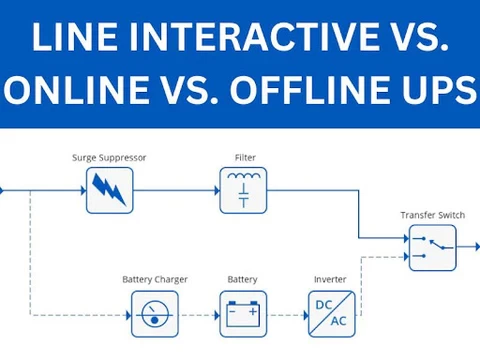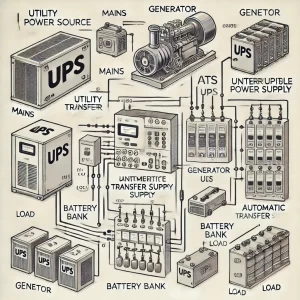Understanding Runtime vs. Load Capacity in Line-Interactive UPS

Line-interactive uninterruptible power supply (UPS) systems offer a reliable solution for safeguarding sensitive electronic equipment from power disturbances and outages. Understanding the relationship between runtime and load capacity is crucial when selecting the right UPS system to meet specific needs. This article delves into the key factors that influence runtime and load capacity in line-interactive UPS systems, enabling informed decision-making for optimal power protection.
Visit Our UPS Systems Study Course
Load Capacity and Power Rating
The load capacity of a UPS system refers to the maximum amount of power it can deliver to connected equipment during a power outage. It is typically measured in volt-amperes (VA) or watts (W). The power rating, often expressed in watts, indicates the actual power the UPS can provide. It's important to note that the VA rating is usually higher than the watt rating due to the power factor, which represents the efficiency of power usage.
Runtime and Battery Capacity
Runtime refers to the duration a UPS system can power connected equipment during a power outage. The battery capacity, measured in ampere-hours (Ah), directly influences runtime. Higher battery capacity generally translates to longer runtime. However, the actual runtime depends on the load and the efficiency of the UPS system.
Factors Influencing Runtime
Several factors impact the runtime of a line-interactive UPS system:
Load Size: The amount of power drawn by connected equipment significantly affects runtime. A higher load will deplete the battery faster, resulting in shorter runtime.
Battery Capacity: As mentioned earlier, larger battery capacity leads to longer runtime. UPS systems often offer options for additional battery packs to extend runtime.
Battery Age and Condition: Over time, batteries degrade, leading to reduced capacity and runtime. Regular battery maintenance and replacement are essential for optimal performance.
UPS Efficiency: The efficiency of the UPS system in converting battery power to AC power impacts runtime. Higher efficiency translates to less energy loss and longer runtime.
Runtime: How Long Can You Last?
Runtime indicates the approximate duration a UPS can keep your equipment powered during a blackout. It's influenced by several factors:
Battery Capacity: UPS batteries store energy and are rated in amp-hours (Ah). Larger batteries naturally enable longer runtimes.
Connected Load: The more power your devices draw, the faster the battery will deplete.
Battery Health: Over time, batteries degrade, reducing their capacity and shortening runtime.
Important Note: Manufacturer-provided runtime estimates are often based on ideal conditions and a partial load. In real-world scenarios, you may experience shorter runtimes.
Translating Specs to Your Needs
Let's say you want to protect a desktop computer drawing 300W, a monitor using 50W, and networking equipment consuming 100W. Your total load is 450W. You'd want a line-interactive UPS with a load capacity exceeding this value.
Runtime becomes critical if you need to save work and gracefully shut down systems. Check the UPS documentation for runtime charts which usually illustrate how long it can sustain different load levels.
Beyond the Basics
Power Factor: Many devices, especially power supplies, have a power factor less than 1, meaning their VA value is higher than their actual power draw in watts. Consider this when sizing your UPS.
Expandable Runtimes: Some line-interactive UPS models allow you to connect additional battery packs to increase runtime.
Line-interactive UPS systems provide essential power protection for sensitive electronics. Understanding the relationship between runtime and load capacity is crucial for selecting the right UPS system. By considering factors such as load size, battery capacity, and UPS efficiency, users can make informed decisions to ensure optimal power backup and safeguard their valuable equipment during power disruptions.
Choosing the right line-interactive UPS involves carefully balancing load capacity and desired runtime. By thoroughly assessing your power requirements and understanding these key metrics, you can ensure that your critical systems remain protected when power from the utility grid falters.





